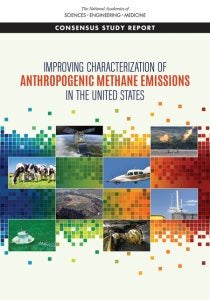 This week the National Academy of Sciences, Engineering and Medicine (NAS), the nation’s most prestigious scientific organization, issued a report calling for a stepped-up nationwide research effort to develop a gridded and verifiable inventory of U.S. methane emissions.
This week the National Academy of Sciences, Engineering and Medicine (NAS), the nation’s most prestigious scientific organization, issued a report calling for a stepped-up nationwide research effort to develop a gridded and verifiable inventory of U.S. methane emissions.
The NAS report, sponsored by the U.S. EPA, Department of Energy (DOE), National Oceanic and Atmospheric Administration (NOAA), and NASA, noted atmospheric methane has risen dramatically in the 20th century, hitting a spike in 2016 that has tripled since pre-industrial times. Methane is a potent greenhouse gas responsible for about 25% of current global warming.
The report discusses all the major U.S. sources of anthropogenic methane emissions, including petroleum and natural gas systems, agriculture, landfills, and coal mines. Researchers acknowledged the rapid increase in natural gas production in the U.S. during the past decade has triggered the need for a better understanding of the energy industry’s methane footprint. The NAS report classified oil and gas as one of three primary research priorities for the future, along rice farming, and livestock.
As EDF has demonstrated, addressing oil and gas production is one of the quickest and most efficient ways to curtail methane emissions. Technology exists to fix methane leaks across the sector’s supply chain, and the International Energy Agency concluded oil and gas operators could reduce 75% of emissions at zero net cost. The NAS report also noted petroleum and natural gas operators could benefit from improved methane inventories and monitoring — improving operational efficiencies to keep natural gas within their system, allowing the gas to be sold and put to useful purposes.
[Tweet “National Academy of Sciences urges collective research improvements to track U.S. methane emissions”]
Currently, the U.S. estimates methane emissions annually in EPA’s Greenhouse Gas Inventory Report (GHGI) which is submitted to the United Nations Framework Convention on Climate Change as part of the U.S.’s climate treaty obligations. The GHGI has improved in recent years with EPA incorporating new findings from data collected through EDF’s extensive methane research project. Yet, there is much more to be done in order to improve the inventory, such as using multiple measurement approaches to better understand emission sources, such as the high emissions resulting from sites with abnormal process conditions, as seen in our work in the Barnett Shale region of Texas, the original site for large scale natural gas development using fracking.
From ground to space
The NAS makes four recommendations to improve our understanding of methane emissions: expand and refine top-down data; develop and maintain a gridded inventory; develop a consistent process for EPA to regularly update inventory; and establish and maintain a nationwide research effort.
Researchers typically measure methane emissions using two approaches – bottom-up and/or top-down. In the bottom-up approach, which includes traditional inventories like the EPA GHGI, emissions are estimated by multiplying activity data (e.g., number of wells) by emission factors (e.g., average emissions per well); these emission factors typically are based on measurements of equipment- or site-level emissions. In contrast, top-down approaches estimate regional emissions based on methane concentrations and atmospheric transport modeling, using tall towers or satellite monitoring from space, or continuous monitoring sensor-based technology placed on planes, drones, helicopters or automobiles.
Each approach has benefits and drawbacks, and, if done correctly, supports the other’s findings. For example, EDF’s previous research in the Barnett Shale found agreement between top-down and bottom-up estimates when inventories accounted for super-emitting facilities. In that work we ensured accurate gathering facility activity data by proactively confirming the correct number of facilities. A key recommendation of the NAS report is that emission inventories should be verifiable, which is difficult to do with national scale inventories. Therefore, NAS recommends the development of a gridded inventory accounting for variations in emissions across space and time. The accuracy of the inventory would be tested and improved upon by comparing the gridded version of bottom-up estimates to top-down estimates, which could be increased in frequency by a combination of ground, air, and satellite-based approaches.
Uniting resources for actionable science
Many of the NAS recommendations, such as establishing a multi-disciplinary advisory board, reflect a more progressive and collaborative approach to research using the latest technology combined with multiple teams of researchers and organizations to derive the most accurate results possible.
EDF has been doing exactly that since we launched our methane research series six years ago, tapping both industry and academic organizations to provide input and support for various parts of the aggressive research effort. The initiative is the largest scientific study effort EDF has tackled in our 50-year history, leveraging partnerships with more than 40 universities and research institutions to undertake the research and the cooperation of dozens of companies. We also helped catalyze the development of a wide range of sophisticated scientific techniques and methodologies, such as top-down, bottom-up, and mobile measuring technology.
Together, EDF’s and NAS’s approach to understanding industry’s methane emissions underscore important considerations that companies, researchers and regulators should take in order to address the challenge of slowing climate change.









